Thomas John Hodge
Family
Thomas John Hodge was born in Dartmouth on 29th November 1883. He was the eldest son of John Thomas Hodge and his wife, Sarah Elizabeth Wotton. For his early life, see the story of his younger brother Frank.
Thomas, who worked as a baker in Dartmouth, married Ada Mary Auger at St Clements, Townstal, on 13th August 1905. Ada was the youngest daughter of Robert Auger, a farm labourer, and his wife Louisa Torr. She was born in Ledstone, in the parish of Charleton, near Kingsbridge, in 1880, where the family was recorded in the 1881 Census. By 1891, they had moved nearby to Buckland Tout Saints, where Ada went to school. By the time of the 1901 Census, Ada had left home to go into domestic service, and was working for John Langworthy, a draper, in Fore Street, Kingsbridge.
Thomas and Ada's first child, Robert John Auger, was born on 6th September 1906 in Dartmouth, and named for both his grandfathers. His brother William Thomas was born in 1909. At the time of the 1911 Census, John, Ada and the two little boys lived at 10 Victoria Cottages, Lake Street, Dartmouth. Thomas continued to work as a baker. Sadly, William died soon after the Census, just past his second birthday. He was buried in St Clements Townstal on 13th July 1911. Another baby, Rita Mary, was born in Dartmouth on 15th August 1912. She and her brother Robert were both baptised at St Saviours on 31st October 1912.
Service
Thomas' service papers have not survived, so his likely career has to be pieced together from a variety of sources. At the time of his death he was serving in the 17th Battalion of the King's Royal Rifle Corps. The KRRC medal roll records that he first joined the Army Service Corps, with the number S4/128163, and this information is also shown in Soldiers Died in the Great War. SDGW records that he enlisted in Kingsbridge, suggesting that by that time he and Ada had moved there from Dartmouth.
The "S4" prefix of his ASC number indicates that he joined the "Supply" section of the Corps, in which the essential trades were butcher, baker, clerk and issuer. It is highly likely that he joined as a baker - the skills and experience he had developed in civilian life were now much needed to feed the rapidly expanding Army in the field. Comparison of his ASC service number with similar service numbers of men whose service papers have survived, indicates that he most probably enlisted in 1915, around the end of August or beginning of September. Joining at this time, he would have been first posted to "A" Supply Company, based at Aldershot, for his initial training.
The ASC Supply side of the Corps was based on supply companies at Aldershot, the Supply Reserve Depot in Deptford, and base, main or field supply depots in the various theatres of war. Where Thomas was posted after training is not known, although his subsequent career suggests he may have gone to France sometime during 1916 or 1917. Initially, the feeding strength of the Army in France was 12,000 men and 40,000 animals; by the end of the war the figures were 3,000,000 and 500,000 respectively. There were three Advanced Supply Depots and four Field Supply Depots in France, with bakeries at Boulogne, Calais, Dieppe, Etaples, Le Havre, Marseilles and Rouen.
The medal roll of the King's Royal Rifle Corps shows that Thomas was one of a fairly large group of men from the Army Service Corps, 32 from "S4", who all transferred to the 21st Battalion of the KRRC with service numbers close to Thomas'. The service record of one of these men has survived (Frank Soper, A/203695) and shows that he was "compulsorily transferred to the KRRC" under authority dated 20th August 1917; the date of his transfer to 21st Battalion was 7th October 1917. Thomas may have been similarly transferred at the same time. As a result of the growing manpower problem, there were regular trawls of supporting corps to identify men who were medically fit and who could be transferred to front-line units. The 21st Battalion was part of 124th Brigade, in 41st Division, and had fought at the Battle of Menin Road, a phase of the Third Battle of Ypres, on 20th September 1917, suffering heavy casualties. But their War Diary for October 1917 (which is very brief) makes no reference to the arrival of this group.
On 7th November, the 41st Division was notified that it was to be transferred to Italy as reinforcements for the Allied front after the defeat at the Battle of Caporetto. The 21st Battalion moved on 12th November by train, arriving north-west of Mantua after a long journey. Between 30th November and 2nd December 41st Division took over a section of the front line behind the River Piave, north-west of Treviso, to which the Italian army had retreated. The Division remained in Italy over the winter holding the line but were not involved in any major action there.
Towards the end of 1917, German troops in Italy were transferred to the Western Front as part of their preparations for the spring offensive. As a result of the build-up, the Government decided that it must withdraw two divisions from Italy and return them to France. The first of these was the 41st Division, which was sent back at the end of February, arriving at Doullens and Mondicourt by 9th March. Immediately on its return the Division was restructured, as part of the major reorganisation of the British Army in which the number of infantry Battalions in each Division was reduced from twelve to nine. The 11th Royal West Kents, the 32nd Royal Fusiliers, and the 21st King's Royal Rifle Corps were the Battalions that disappeared; the 21st Bn KRRC was disbanded on 16th March 1918 and the men were distributed amongst other KRRC Battalions. It seems most likely that it was at this point that Thomas transferred to the 17th Battalion, his final unit.
It is not clear whether Thomas had arrived with his new Battalion by the time of the start of the German Spring Offensive only a few days later. There is no reference in the 17th Bn War Diary to any transfers of other ranks from 21st Bn KRRC (or anywhere else) in the week leading up to the start of the offensive, nor at any later date (though two ex-21st Bn KRRC officers are noted as arriving on 10th April).
17th Battalion
The 17th Battalion was part of 117th Brigade, in 39th Division. On 21st March 1918 the Division was in reserve, working on the rear defences. The Battalion was at Sorel-le-Grand. The mood was described by 2nd Lt Frank Warren in his diary:
Last night, after a jovial evening in our mess, we went to bed in a wooden hut, with a dim notion of the possibilities of the morrow, but with no special preparations for a "stand to". It is 4.30am of the 21st when we are awoken by a crashing bombardment, and its intensity leaves no room for doubting its purpose…
The bombardment reached deep behind the front line - "A" Company's huts were shelled and thirteen men (according to the War Diary) were wounded; when the Battalion assembled at Sorel Wood, the assembly position was also shelled, causing further casualties. At 7pm they moved to south-east of Saulcourt and dug in "to protect the right flank of 21st Division" (for the experience of 21st Division on the first day of the attack, see the story of Reginald Drake).
On 22nd March at Saulcourt they suffered heavy casualties; they were ordered to withdraw to the "Green Line" at Tincourt Wood at 5pm and cover the withdrawal of the rest of the Brigade.
On 23rd March "at dawn under cover of a heavy mist the enemy attacks in great numbers. Very fierce fighting takes place …". They were then ordered to withdraw, reaching a position at 1pm "between Bussu and Aizecourt"; but soon afterwards were ordered to withdraw to a position "east of Mount St Quentin", which was held for "half an hour", long enough to allow the transport to get away, before orders were received to cross the Somme at Clery-sur-Somme. A line was taken up along the south side of the Somme Canal.
On 24th March the Brigade was responsible for defending the Feuilleres bridgehead, across the Somme River; the enemy did not attack, and the bridge was blown up at 10.30pm. 2nd Lt Frank Warren recorded:
We are wondering what our defence of the bridgehead might mean, when - a rending zoom and fragments of bridge fly 100 to 200 feet into the air, all falling nearly on the same spot. Our work is done for the time being.
On 25th March there was a brief pause and that night (25th/26th) the 17th KRRC withdrew to a position "between Herbecourt and Frise". By this time the Brigade was reduced to less than half its original numbers. After enemy attack in force at about 8am, and heavy fighting, the Division withdrew further "fighting all the time". The 17th Battalion reached first a position south of Eclusier, and then at 11am were ordered to retire to Proyart. The chaos of the withdrawal was described by Frank Warren:
The troops on our left have all come in on top of us. Next we see troops on our right coming back fast. As the battalions get more and more mixed, order is fast disappearing … The men are mixed up in bewildered groups … I lose touch with them. Reluctantly we follow the fugitive stream, until we can reach a spot where we can re-form and regroup our men …
Finally on 27th March at a position between Morcourt (on the south bank of the Somme) and the Amiens road (now the D1029) they were able briefly to establish a proper line of defence. At this point, due to the heavy casualties suffered, they were temporarily amalgamated with 16 Rifle Brigade into a composite battalion.
By the following morning, however, the Germans, having advanced on the north bank of the Somme and having crossed the river at Cerisy, had taken Morcourt on the Battalion's left, and also taken the village of Lamotte, further west to the rear. The amalgamated Battalion was ordered at 6am (28th March) to withdraw via the village of Wiencourt, eventually reaching a position by 3am on 29th March on the Aubercourt-Marcelcave road where they occupied some old tunnels. That day (which happened to be Good Friday), no attack was delivered and the situation remained quiet.
On 30th March at 6.30am the enemy attacked "along the whole front"; the line drew back but a succession of counter-attacks regained the starting position. During the fighting, 2nd Lt Frank Warren was wounded, recorded in the War Diary, and also by himself:
Suddenly I am knocked spinning with a numbing blow on the back of the head. I fall instinctively, rather than by the force of the blow, and my first thought is that it is all over and I am dead. Then I hear someone calling, "Warren's hit! Warren's down!" Several men come running round me … I … beg [Sergeant Page] not to let a crowd assemble or it will draw fire and someone else will be shot … I sit up and unbuckle my equipment, which with revolver, ammunition pouch, glasses, compass, haversack and water bottle is no mean weight … I find I can now stand well … so … with the parting words "Give them one for me!" I begin my journey off the field.
Finally the Brigade was withdrawn at 7pm to billets at Longeau, just east of Amiens; on arrival, the temporary amalgamation of the 17th Bn KRRC with the 16th Bn Rifle Brigade ceased. At this point, the War Diary recorded the 375 casualties incurred since the start of the German offensive:
Similar losses were experienced across the whole 39th Division. Over the next few days the remnant of the 17th Bn KRRC moved by march, lorry and train to billets at Moulle, north of St Omer, to rest and regroup. However, it was not long before they were required to confront the second phase of the German spring offensive.
The Battle for Flanders: the Lys Offensive
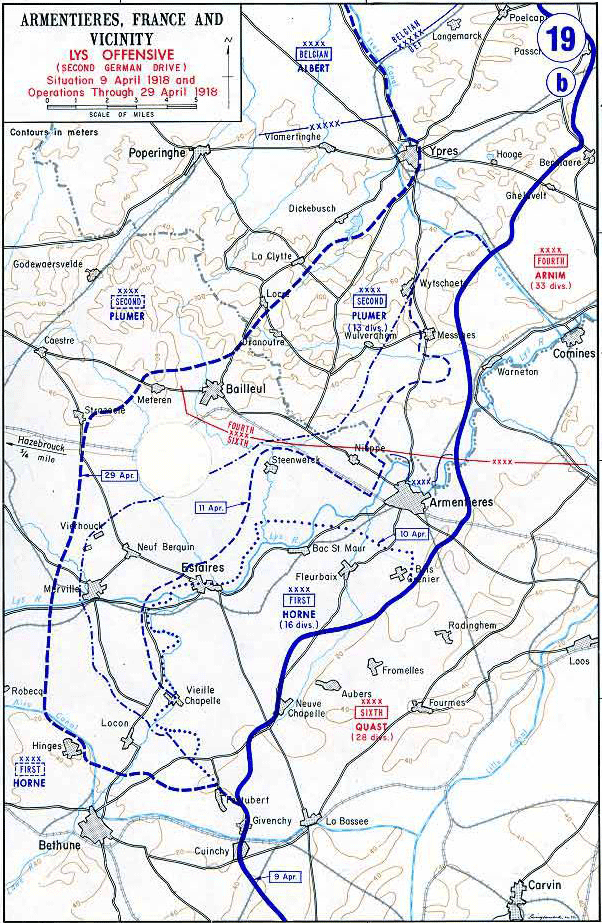
On 9th April 1918, the Germans attacked between Armentieres and the La Bassee Canal. Here Thomas' youngest brother Frank was part of the successful defence by the 55th Division at the extreme south of the line, at Givenchy. But elsewhere the Germans broke through, achieving a gain of up to 5½ miles. The following day they attacked between Armentieres and Ypres.
In response Divisions were moved up from Third and Fourth Armies and even the battered 39th Division, which had been earmarked for training the incoming Americans, was brought back into the fight. On 10 April 1918, most of what was left of it was formed into "39th Composite Brigade", with 117th Bde (16th Sherwood Foresters, 17th KRRC, and 16th Rifle Brigade) in turn formed into "No 3 Composite Battalion". According to their War Diary, the total strength of 17th KRRC was at this time 6 officers and 333 ORs.
On 14th April 1918, another Composite Battalion, no 5, had to be raised by the Division, 117th Brigade having to find a composite company. To this, 17th Bn KRRC supplied 101 other ranks and the transport. No 5 Composite Battalion was sent to 1st Australian Division, which had been brought up to contribute to the defence of Hazebrouck, a vital communications centre threatened by the German advance. Hazebrouck did not fall; the men in no. 5 Composite Battalion rejoined 17th KRRC on 30th April, having incurred casualties during that time of one OR killed and one OR wounded.
It appears that Thomas must have been part of no. 3 Composite Battalion, which was sent to the sector of the line south of Ypres on 11th March, leaving at 3am by rail from St Omer. On 16th April 1918 they were part of the counter-attack by 9th Division, together with a French Division, to recover the village of Wytschaete, which had fallen to the Germans the day before. In the event the French did not attack; 9th Division reached the village and held out until the next day, but then had to retire.
The War Diary of No. 3 Composite Battalion recorded some initial success, with the gain of 800 yards, and the capture of a "number of machine guns and prisoners", by the two Sherwood Forester companies, who were earmarked for the attack.
The two Rifle companies, in the meantime, after a fruitless march west to Reningelst and back, for a purpose not identified in the War Diary, were ordered into support positions behind Wytschaete, where they stayed for the next three days, under orders of the 1st South African Regiment. On 19th April, they were relieved by the two Sherwood Forester companies and returned to camp at Awapuni Lines, north of Dickebusch Lake. Although the Rifle companies do not seem to have been directly involved in the attack, the rear areas were subject to heavy shelling and they sustained significant casualties. The Composite Battalion War diary records the daily casualties separately for each of its original contingent Battalions, so we know that the 17th Bn KRRC casualties were, for this period:
Death
"Soldiers Died in the Great War" records that Thomas "died of wounds" on 19th April 1918. The Composite Battalion War Diary does not record anyone as having "died of wounds" on that date, though it does record individuals as such on other days.
However, Thomas' entry in the Register of Soldiers' Effects notes, for date of death: "on or since 19th April death presumed", suggesting that Thomas was one of the 14 men declared missing on 19th April 1918.
Evidently there was uncertainty about what had happened to him; on 2nd June 1918, Ada placed a notice in The People, in a column headed "Missing Soldiers: Concerning Whom Information Is Wanted":
Hodge: Rfmn T J., A203649, K R R Corps - Missing April 19 - Mrs Hodge, 1, Flora Place, Ebrington Street, Kingsbridge
When Thomas' death was finally confirmed is not known. Ada remarried in 1921.
Commemoration
It seems that Thomas' body was never found, or never identified, for he is one of 35,000 men with no known grave commemorated on the Tyne Cot Memorial, nearly all of whom died in the Ypres Salient between August 1917 and November 1918.
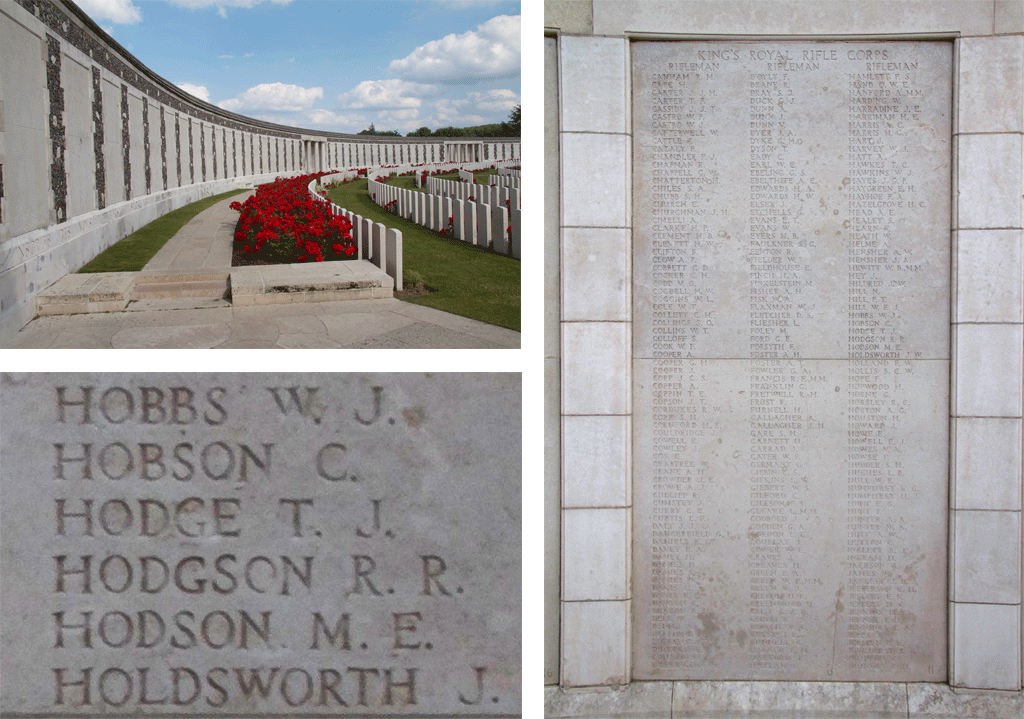
Thomas is commemorated in Dartmouth on the Town War Memorial and the St Saviours Memorial Board, along with his brother Frank. His presumed date of death was just ten days after Frank's.
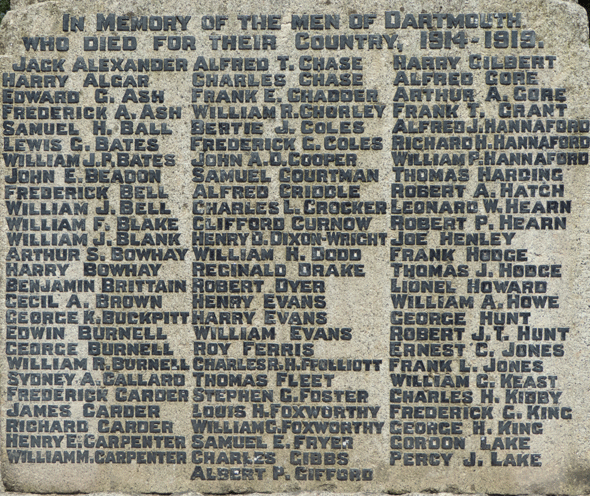
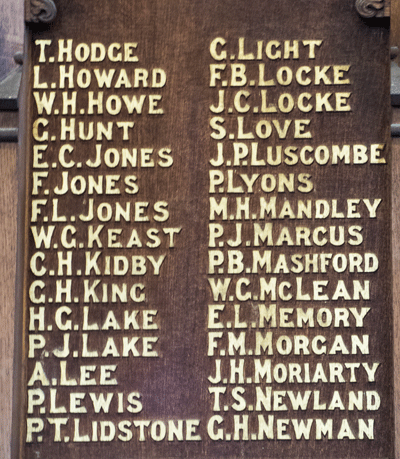
He is also commemorated on the Kingsbridge War Memorial.
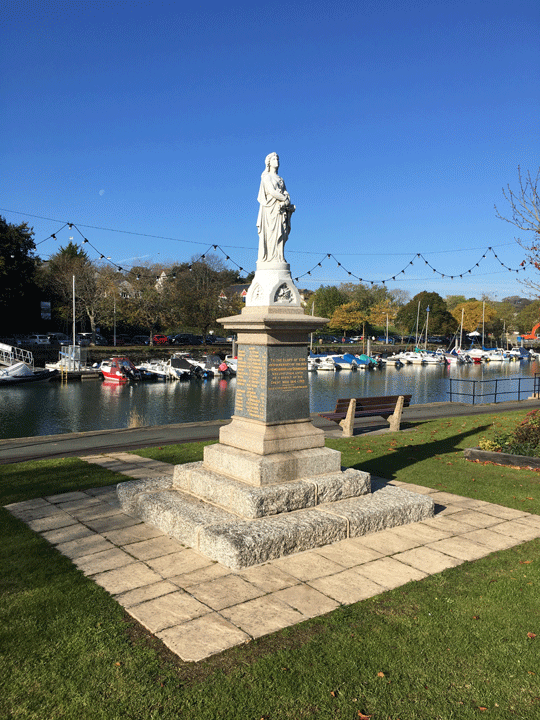
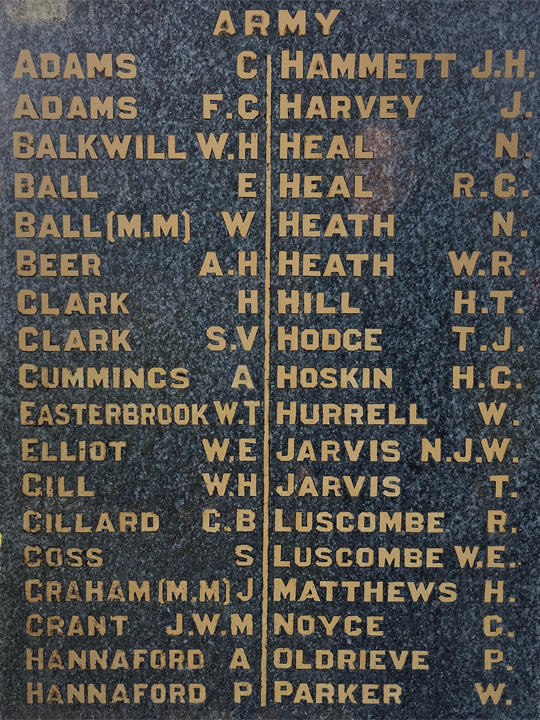
Sources
Wait for the Waggon: The Story of the Royal Corps of Transport and its Predecessors 1794-1993, edited by John Sutton, pub Pen & Sword Books, 1998; includes The Role of the Army Service Corps in the First World War
War Diary of 21st Battalion King's Royal Rifle Corps May 1916 - October 1917 available at the National Archives, fee payable for download, reference WO 95/2643/4
War Diary of 17th Battalion King's Royal Rifle Corps April 1915 - June 1919 available at the National Archives, fee payable for download, reference WO 95/2586/2
War Diary of 39 Division Composite Brigade 3 Composite Battalion April 1918 available at the National Archives, fee payable for download, reference WO 95/2587
The Annals of the King's Royal Rifle Corps, Volume V, The Great War, by Major-General Sir Steuart Hare, pub John Murray, London, 1932
1918, A Very British Victory, by Peter Hart, pub Weidenfeld & Nicholson, London, 2009; including the quotations from the diary of 2nd Lt Frank Warren
Information Held on Database
| Surname: | Hodge |
| Forenames: | Thomas John |
| Rank: | Rifleman |
| Service Number: | A/203649 |
| Military Unit: | 17th Bn Kings Royal Rifle Corps |
| Date of Death: | 19 Apr 1918 |
| Age at Death: | 36 |
| Cause of Death: | Died of wounds |
| Action Resulting in Death: | Battle of the Lys |
| Place of Death: | Near Dickebusch, Belgium |
| Place of Burial: | Commemorated Tyne Cot Memorial, Belgium |
| Born or Lived in Dartmouth? | Yes |
| On Dartmouth War Memorial? | Yes |
| On St Saviour's Memorials? | Yes |
| On St Petrox Memorials? | No |
| On Flavel Church Memorials? | Yes |
| In Longcross Cemetery? | No |
| In St Clement's Churchyard? | No |
| On a Private Memorial? | No |
| On Another Memorial? | Yes |
| Name of Other Memorial: | Kingsbridge War Memorial |















